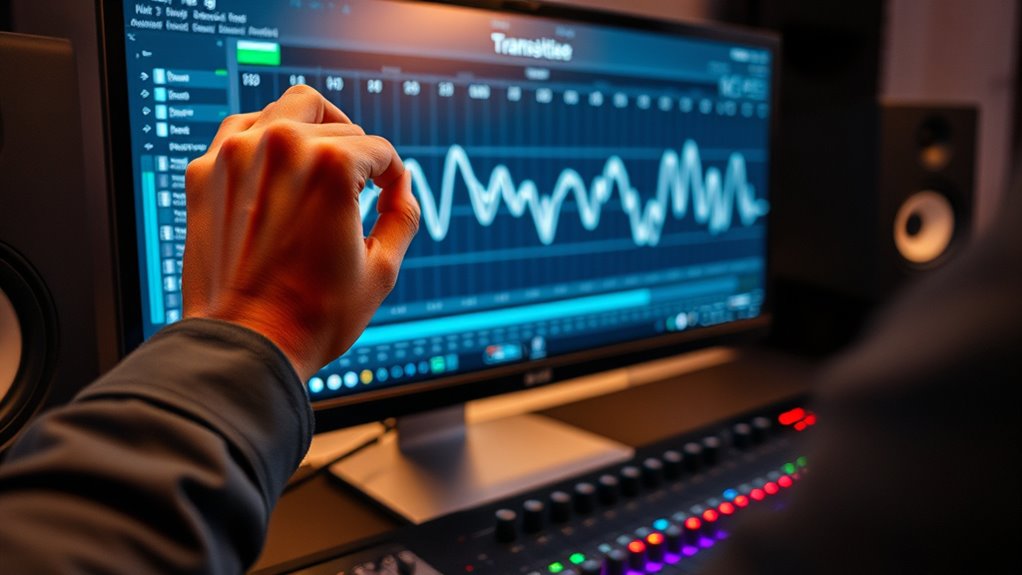To add punch with transient designers, focus on emphasizing the attack of your sounds to make them more lively and impactful. Use the control to boost the initial transient, which brings clarity and tightness to drums, guitars, and vocals. Don’t overdo it—finding the right balance prevents harshness or unnatural sound. With proper use, your mix will sound more energetic and focused. Keep exploring these techniques to learn how to shape your sounds perfectly.
Key Takeaways
- Emphasize the attack phase of sounds to add snap and presence, making drums and percussion more punchy.
- Use transient shaping to increase the initial transient, creating a more energetic and lively sound.
- Balance attack and sustain controls to enhance punch without making sounds overly aggressive or unnatural.
- Apply transient designers to sculpt sounds, ensuring they cut through the mix clearly and with impact.
- Subtly tighten the attack to improve overall mix clarity and achieve a more powerful, cohesive sound.

Have you ever wanted to add more punch and clarity to your mix? That’s where transient designers come into play. They’re powerful tools that help you shape the attack of individual sounds, giving your mix a more defined and energetic feel. When used correctly, a transient designer can make drums hit harder, guitars snap into place, and vocals cut through the mix with precision. The key is understanding how to manipulate attack and sustain without disrupting the overall mix balance. This control allows you to emphasize the punchiest parts of a sound while gently taming or extending others, resulting in a more impactful and balanced result.
By focusing on attack clarity, you can bring out the initial transient of each instrument, making them sound more lively and present. For drums, this means you can accentuate the initial hit to give them more snap and presence. For percussion or plucked instruments, it enhances the attack, making each note stand out clearly. This clarity directly contributes to the perceived punch of your mix, giving it that energetic push that grabs the listener’s attention. When you dial in attack with a transient designer, you’re fundamentally highlighting the part of the sound that defines its character. It’s like tightening the initial grip of a handshake, making the sound more assertive and crisp.
At the same time, a transient designer helps you maintain or improve your mix balance. Too much attack can make a track feel overly aggressive or out of place, so you need to find the right sweet spot. Conversely, reducing attack can soften sounds that are too harsh or overly prominent. By blending these adjustments, you can craft a cohesive sound where each element complements the others, preventing any single instrument from overpowering the mix. This control is especially beneficial in busy mixes, where clarity and separation matter. When your attack is well defined, every element has its space, and your mix sounds more polished.
Using a transient designer isn’t just about making sounds louder or sharper; it’s about shaping their transient profile to serve the overall mix. It’s a subtle art of enhancing attack clarity without sacrificing natural tone. When you master this, your mixes will feel more vibrant, punchy, and balanced. So, the next time you’re working on a track that needs a little extra kick, reach for a transient designer. Experiment with attack and sustain controls, and see how you can sculpt your sounds to punch through with clarity while maintaining perfect mix harmony. Recognizing the importance of proper dynamic control can dramatically improve your mixing results.
Frequently Asked Questions
Can Transient Designers Be Used on Vocals Effectively?
Yes, you can use transient designers on vocals effectively. They give you dynamic control, allowing you to tame harsh transients or emphasize attack for more presence. Additionally, you can experiment with creative effects by shaping the transients to add unique textures or rhythmic accents. Just be subtle to preserve the natural feel, or go bold for more dramatic transformations—transient designers are versatile tools for vocal processing.
What Genres Benefit Most From Transient Designer Processing?
You’ll find that genres like rock, pop, and electronic music benefit most from transient designer processing. It helps you enhance drum attack, making kicks and snares punchier, and shapes percussion to fit perfectly in the mix. By controlling transients, you can add punch and clarity, ensuring each element stands out. This technique is especially useful when you want a tighter, more impactful sound across these energetic genres.
How Do Transient Designers Affect Mix Clarity?
Transient designers improve mix clarity by shaping attack and release, allowing you to emphasize or tame specific transients. This dynamic shaping helps separate elements, making each sound more distinct. By controlling how quickly sounds hit and fade, you can reduce muddiness and enhance definition. Using these tools effectively results in a cleaner, more focused mix, ensuring each instrument stands out without cluttering the overall sound.
Are There Any Drawbacks to Overusing Transient Designers?
Overusing transient designers can reduce your mix’s dynamic range, making the audio sound overly compressed and less lively. It might also introduce unnatural artifacts, causing a loss of punch and clarity. When you rely too heavily on these tools, you risk diminishing the natural dynamics that give your mix energy. Use transient designers sparingly to maintain balance, ensuring your tracks retain their punch without sacrificing overall audio quality.
Which Transient Designer Plugins Are Considered the Best?
Think of transient designers as sculptors shaping your sound’s dynamic range, attack, and sustain. The SPL Transient Designer is a top-tier choice, offering precise control with intuitive controls. Waves Transient Shaper and FabFilter Saturn also shine, providing versatile options to enhance punch and clarity. These plugins let you carve out space in your mix, giving your drums and instruments the perfect punch without sacrificing natural feel.
Conclusion
By using transient designers for punch, you harness the tool like a painter with a fine brush, adding precise strokes to your mix. They allow you to shape and carve out punchy, impactful sounds that cut through the clutter. With a little finesse, you’ll turn your tracks into a vibrant tapestry of energy and clarity, where every hit feels intentional. Embrace the power of transient designers—they’re your secret weapon to make your punch stand tall in the mix.









